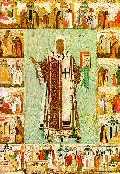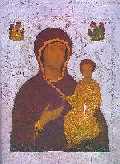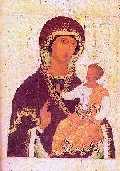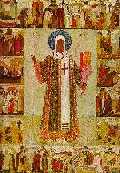





Dionisii. From left to right: The Metropolitan Alexis, with Scenes from His Life (1480s), The Virgin Hodegetria (1482), The Virgin Hodegetria (1502-1503), The Metropolitan Peter, with Scenes from His Life (1480s).
Dionisii (Dionysius) was born around 1440. He was first mentioned as a member of the team working on the paintings in the Cathedral of the Nativity in the Pafnutyev Monastery. During Dionisii's life the Muscovite state succeeded in finally subjugating the independent Republic of Lord Novgorod the Great and shaking off the yoke of the Mongol control.
Continuing the traditions of Moscow icon painting, Dionisii developed a light, elegant, and sophisticated style. While traditionally the head of a represented figure fit in the body about seven times, in Dionisii's art the ratio increased to nine, sometimes even ten. His figures became elongated and buoyant through a drastic reduction of the sizes of the heads, hands, and feet. To increase the effect of ethereal elongation Dionisii used "draperies in such a way as to outline the flesh and muscles which they cover." The color palette of Dionisii also differed from the traditional palette of the Moscow artists. He introduced pastel colors, especially turquoise, pale green, and rose. By using these painterly devices, Dionisii was able to "emphasize the mystical over the dramatic content of narrative scenes."
Among the most important works attributed to Dionisii were The Crucifixion, The Metropolitan Alexis, with Scenes from His Life, The Metropolitan Peter, with Scenes from His Life, and two icons of The Virgin Hodegetria. The Crucifixion, which was painted around 1500 has a refined color palette and elegant composition. Slightly earlier, Dionisii and his workshop completed the hagiographical icons of Alexis and Peter. In the first, probably painted by the master himself, we see the pastel color palette characteristic of Dionisii's later works. The delicate elongated figures almost float through the compositions of the border scenes describing events from the bishops' lives, making the images deeply spiritual and detached from reality. [K.T.]
[Sources: Britanica Online, Bulkin].
